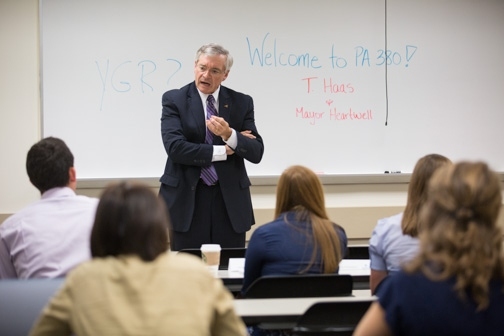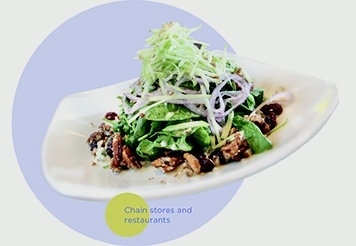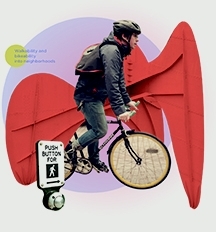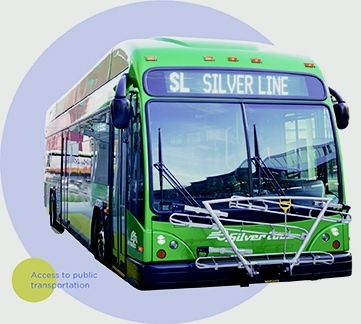YGR
Students advise mayor on retaining talent
Cities across the country are trying to figure out how to retain talent and keep recent college graduates and young professionals.
While some experts are concerned there is a “brain drain” of talented and highly educated young people leaving Michigan, a survey of Grand Valley graduates shows 86 percent are living and working in the state.
In his 2014 State of the City address, Grand Rapids Mayor George Heartwell said retaining talent is one of his top priorities. He announced a new partnership with the university in which he would receive help from Grand Valley students. He asked the students to study the city’s efforts to retain and attract millennials while studying similar efforts across the country.
“We want to ensure that when our college students complete their degrees they want to stay in Grand Rapids,” Heartwell said in his address. “In a knowledge economy such as ours, talent is wealth. The cities that retain and attract talent are winning; the others are losing.”
The partnership meant forming a new course for the fall 2014 semester; 13 students served as a focus group and at the end of the semester they reported their findings and suggestions to city officials.
“The diverse group of students represented a variety of majors like business, political science, anthropology and public administration — that was by design,” said Mark Hoffman, associate professor of public administration, who taught the class.
During the semester, students heard presentations from various neighborhood and community groups like The Rapid, Friends of Grand Rapids Parks, Global Bridgebuilders, Hello West Michigan, Challenge Detroit, Experience Grand Rapids, The Gordon Group Realtors, City of Grand Rapids and more.

Grand Rapids Mayor George Heartwell speaks to Grand Valley
students about retaining talent.
photo by Amanda Pitts

Chain stores and restaurants
“The students didn’t do original research, their job was to listen to ideas from the guest speakers and determine which ones were appealing, which ones would be best to move on,” said Hoffman, who also serves as associate dean of the College of Community and Public Service. “The students are the demographic the city is asking them to talk about. Who better to talk about this than these young professionals?”
On the first day of class, students were given a charge by the mayor and President Thomas J. Haas, as Haas wrote on the board, “YGR — Why Grand Rapids?”
City strengths
The students worked in groups, highlighting key issues important to millennials such as employment, affordable housing, transportation, entertainment, diversity and sustainability. They studied success stories from cities like Boston, Portland, Austin, Washington, D.C., and Detroit.
Chris Stoffel, 30, a senior from Chicago studying anthropology, said the class didn’t identify one big splashy idea that would be a magic bullet.
“It was insightful hearing from community members,” said Stoffel. “We can’t say one specific change will make people want to move to Grand Rapids because everything is connected. For example, the bus system attracts millennials but it also has an impact on sustainability and an impact on where you live and on housing, which can also have an affect on diversity. We are looking at a lot of smaller, different changes.”
Key suggestions from students
- Create an app platform — YGR
- Create more undergraduate and high school work experience jobs
- Create more neighborhood distinction and charm
- Develop a diversity network
- Create a millennials advisory board
- “Make Your Mark” branding campaign
The class found Grand Rapids already has some key components to retaining and attracting young professionals, like walkable neighborhoods, bike paths and public parks.
“Millennials pay attention to the city culture during the day,” said Jacob Schacht, 20, a political science major from Mattawan. “If people believe there are things to do, they will spend more time in the city and want to live in the
city. Walkability and bikeability in Grand Rapids are crucial.”
The students found that good public transportation was near the top of the wish list for young professionals and said Grand Rapids is on the right track.
“We heard from a representative from The Rapid and they are doing a great job,” said Olivia Jenison, 21, a public and nonprofit administration major from Howell. “The bus system is already improving and we are encouraging
them to continue to expand. The Silver Line (which connects Grand Rapids, Kentwood and Wyoming) was a great idea. It brings more people to the city by bus than by car.”
There's an app for that
Millennials rely on their smartphones for information and navigation. Students suggested creating an app connecting all aspects of Grand Rapids that would include a virtual entertainment district, easy-to-identify events for 18- to 21-year-olds, restaurants and a quick trip calculator of bus routes.
“It would be challenging to create the app because of all the existing guides,” said Allison Ives, 20, a public administration and health communications major from Canton. “But, this type of app has been successful in a number of other cities.”
Students also said more work needs to be done connecting college students to local jobs and internships.
“Employers are looking for experience so it would be beneficial for students to get job experience while still in the education system, like through an internship,” said Schacht. “Many get hired through internships and then are more likely to stay. A job and low housing costs are what I’m looking for in a city, and then I consider the cool stuff to do.”

Walkability and bikeability into neighborhoods
Jenison said finding a job is a big worry for college graduates. “Entry-level jobs are hard to find in the area, so internships are key to staying,” she said. “There is a thought that millennials find a cool city and then look for a job, but that’s not necessarily so. Many of us are looking for jobs first.”
The group pointed out that Grand Rapids can look dull to a visitor scanning the streets for activity.
“We want to live in a vibrant, lively city with an entertainment district,” said Stoffel. “It’s important to me to have a place to go after work. You can find great food downtown and the atmosphere is friendly, but we don’t have a huge entertainment district; it’s spotty throughout the city.”
Ives said it would help if establishments in the city stayed open later, especially for those under 21. “We need a range of experiences because connection to a city starts young,” she said.
Another suggestion called for the formation of a diversity network to promote diversity and inclusion.“Diversity is huge in attracting talented people,” said Schacht. “There is diversity in Grand Rapids but it is still too segregated. The area is very friendly but it is more of a ‘hi, bye’ culture instead of really interacting with others.”

Access to public transportation
Make your mark
Perhaps one of the most attractive aspects of Grand Rapids is the possibility for millennials to help shape the city’s identity.
The students suggested a “Make Your Mark” branding campaign, highlighting the city’s ideal size and featuring young professionals in Grand Rapids who have distinguished themselves in the business, nonprofit or government sectors.
Stoffel said he is staying in Grand Rapids after graduation instead of returning to his hometown of Chicago because of the opportunity to make a mark. “Grand Rapids is one of those unique cities where millennials can fulfill that desire to make a mark. Right now in Grand Rapids we have the unique ability to make it our own place,” said Stoffel.
“Detroit is known as the Motor City with Motown and its long history, but we are in this unique period where we can make the city great. We can help the city grow to what we would like it to be, whether it’s Beer City or being a sustainable city, or known for education — we can make a namesake.
“There are a lot of inventors, entrepreneurs and creativity in this generation. Millennials want to make a mark in history; they don’t want to be a forgotten generation.”
Heartwell said he plans to implement three of the students’ recommendations, including the development of the smartphone app that will include information about city restaurants, stores, attractions, transportation and more. Grand Valley students will help develop the app.
The mayor said he will also form a Millennial Advisory Board, made up of representatives from area colleges and universities and from young professional organizations. He said his initiative, the Mayor’s 50, will be expanded to the Mayor’s 100, to offer students more internship opportunities with local businesses.
